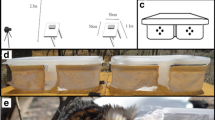Abstract
Western scrub-jays (Aphelocoma californica) hide food and rely on spatial memory to recover their caches at a later date. They also rely on observational spatial memory to steal caches made by other individuals. Successful pilfering may require an understanding of allocentric space because the observer will often be in a different position from the demonstrator when the caching event occurs. We compared cache recovery accuracy of pairs of observers that watched a demonstrator cache food. The pattern of recovery searches showed that observers were more accurate when they had observed the caching event from the same viewing direction as the demonstrator than when they had watched from the opposite direction. Search accuracy was not affected by whether or not the tray-specific local cues provided left–right landmark information (i.e. heterogeneous vs. homogeneous local cues), or whether or not the caching tray location was rotated. Taken together, these results suggest that observers have excellent spatial memory and that they have little difficulty with mental rotation.








Similar content being viewed by others
References
Baron-Cohen S (1988) Social and pragmatic deficits in autism: cognitive or affective? J Autism Dev Disord 18:379–402
Balda RP, Kamil A (1992) Long-term spatial memory in Clark’s nutcracker. Nucifraga columbiana. Anim Behav 44:761–769
Bednekoff PA, Balda RP (1996a) Social caching and observational spatial memory in pinyon jays. Behav 133:807–826
Bednekoff PA, Balda RP (1996b) Observational spatial memory in Clark’s nutcrackers and Mexican jays. Anim Behav 52:833–839
Bednekoff PA, Balda RP (1997) Clark’s nutcracker spatial memory: Manay errors might not due to forgetting. Anim Behav 54:691–698
Brockmann HJ, Barnard CJ (1979) Kleptoparasitism in birds. Anim Behav 27:487–514
Brodin A, Kunz C (1997) An experimental study of cache recovery by hoarding willow tits after different retention intervals. Behaviour 134:881–890
Brodin A, Ekman J (1994) Benefits of food hoarding. Nature 372:510
Bugnyar T, Kotrschal K (2001) Do ravens manipulate the others´ attention in order to prevent or achieve social learning opportunities? Adv Ethol 36:106
Burnell KL, Tomback DF (1985) Stellar’s jays steal gray jay caches: field and laboratory observations. Auk 102:417–419
Clayton NS, Dickinson A (1998) Episodic-like memory during cache recovery by scrub jays. Nature 395:272–278
Clayton NS, Dickinson A (1999). Scrub Jays (Aphelocoma coerulescens) remember the relative time of caching as well as the location and content of their caches. J Comp Psychol 113:403–416
Clayton NS, Griffiths DP, Emery NJ, Dickinson A (2001) Elements of episode-like memory in animals. Phil Trans Roy Soc Lond B 356:1483–1491
Coussi-Korbl S (1994) Learning to outwit a competitor in mangabeys (Cercocebus torquatus torquatus). J Com Psychol 108:164–171
Ekman J, Brodin A, Sklepkovych B (1995) Selfish long-term benefits of hoarding in the Siberian jay. Behav Ecol 7:140–144
Gibb JA (1960) Populations of tits and gold crests and their food supply in pine populations. Ibis 102:163–208
Healy SD, Suhonen J (1996) Memory for locations of stored food in willow tits and marsh tits. Behaviour 133:71–80
Heinrich B, Pepper JW (1998) Influence of competitors on caching behavior in the common raven, Corvus corax. Anim Behav 56:1083–1090
Heinrich B (1999) Mind of the Raven. Harper Collins, New York
Held S, Mendl M, Devereux C, Byrne RW (2000) Social tactics of pigs in a competitive foraging task: the “informed forager” paradigm. Anim Behav 46:177–188
Herman LM, Pack AA, Morrel-Samuels P (1993) Representational and conceptual skills of dolphins. In: Roitblatt HL, Herman LM, Nachtigall PE (Eds) Language and communication: comparative perspectives. Erlbaum, Hillsdale, pp 403–442
Hitchcock CL, Sherry DF (1990) Long-term memory for cache sites in the black-capped chickadee. Anim Behav 40:701–712
Hollard VD, Delius JD (1982) Rotational invariance in visual pattern recognition by pigeons and humans. Science 218:804–806
Hopkins WD, Fagot J, Vauclair J (1993) Mirror-image matching and mental rotation problem solving by baboons (Papio papio): unilateral input enhances performance. J Exp Psychol: General 122:61–72
Huttenlocher J, Presson CC (1973) Mental rotation and the perspective problem. Cogn Psychol 4:279–299
Huttenlocher J, Presson CC (1979) The coding and transformation of spatial information. Cogn Psychol 11:375–394
Mauck B, Dehnhardt G (1997) Mental rotation in a California sea lion (Zalophus californianus). J Exp Biol 200:1309–1316
Piaget J, Inhelder B (1956) The child7s conception of space. Routledge and Kegan Paul, London
Presson CC (1982) Strategies in spatial reasoning. J Exp Psychol Hum Percept Perform 14:3–11
Preston S, Jacobs L (2005) Decisions in Merriam’s kangaroo rat (Dipodomys merriami). J Comp Psychol 119:187–196
Shepard S, Metzler D (1971) Mental rotation of three-dimensional objects. Science 171:701–703
Shettleworth SJ (1995) Memory in food-storing birds: From the field to the Skinner box. In: Alleva E, Fasolo A, Lipp H-P, Nadel L (eds) Proceedings of NATO Advanced Study Institute Series Maratea, Italy. Kluwer Academic Publishers, The Hague, pp 158–179
Vader Wall SB (1982) An experimental analysis of cache recovery in Clark’s nutcracker. Anim Behav 30:84–94
Watanabe S (1997) An instance of viewpoint consistency in pigeon object recognition. Behav Proc 39:257–261
Watanabe S (1999) Enhancement of viewpoint invariance by experience in pigeons. Curr Psychol Cogn 18:322–336
Watanabe S (2005) Strategies of spatial learning for food storing in scrub jays. J Ethiol 23:181–187
Whiten A, Perner J (1991) Fundamental issues in the multidisciplinary study of mind reading. In: Whiten A (Ed) Natural theories of mind: evolution, development and simulation of everyday mind reading. Blackwell, Oxford
Acknowledgments
These experiments were carried out in the department of experimental psychology, Cambridge University. The research was supported by Exchange Program of Keio University and Downing College, and The 21 Century COE Program (D-1) in Japan.
Author information
Authors and Affiliations
Corresponding author
About this article
Cite this article
Watanabe, S., Clayton, N.S. Observational visuospatial encoding of the cache locations of others by western scrub-jays (Aphelocoma californica). J Ethol 25, 271–279 (2007). https://doi.org/10.1007/s10164-006-0023-y
Received:
Accepted:
Published:
Issue Date:
DOI: https://doi.org/10.1007/s10164-006-0023-y




